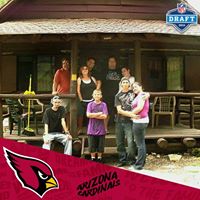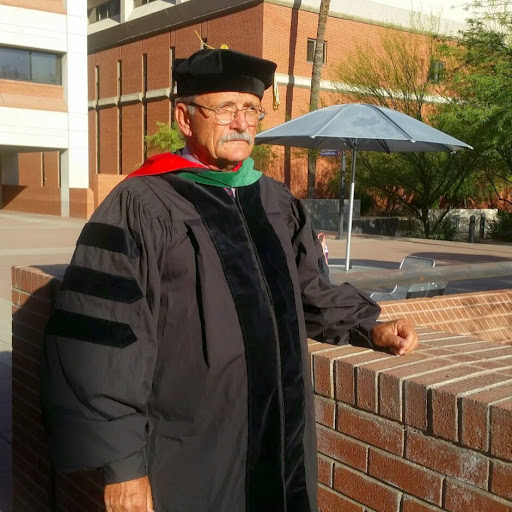Douglas S Larson
age ~66
from Inver Grove, MN
- Also known as:
-
- Doug S Larson
- Douglas S Helmin
Douglas Larson Phones & Addresses
- Inver Grove, MN
- Sioux Falls, SD
- Saint Paul, MN
- Minnetonka, MN
- Sartell, MN
- Minneapolis, MN
Isbn (Books And Publications)

Write in the Middle 2E: A Guide to Writing for the Esl Student
view sourceAuthor
Douglas Larson
ISBN #
0030222974

Cliff Ecology: Pattern And Process in Cliff Ecosystems
view sourceAuthor
Douglas W. Larson
ISBN #
0521019214
Medicine Doctors

Douglas Glen Larson
view sourceSpecialties:
Internal Medicine
Nephrology
Diagnostic Radiology
Nephrology
Diagnostic Radiology
Us Patents
-
Method For Decoding Addresses Using Comparison With Range Previously Decoded
view source -
US Patent:6349376, Feb 19, 2002
-
Filed:Jul 7, 1998
-
Appl. No.:09/111243
-
Inventors:Douglas Alan Larson - Lakeville MN
-
Assignee:Micron Technology, Inc. - Bosie ID
-
International Classification:G06F 1206
-
US Classification:711211, 711209, 36523006, 365233
-
Abstract:A method for providing the results of an address decode operation involves comparing the address of an address to be decoded with the address range containing an address previously decoded in a previous address decode operation, selecting the results of the previous address decode operation if the address of an address to be decoded is within the address range containing an address previously decoded in a previous address decode operation, and decoding the address to be decoded in a current address decode operation and selecting the results of the current address decode operation if the address containing an address to be decoded is not within the address range of an address previously decoded in a previous address decode operation.
-
Method For Selectively Encoding Bus Grant Lines To Reduce I/O Pin Requirements
view source -
US Patent:6363446, Mar 26, 2002
-
Filed:Jun 12, 1999
-
Appl. No.:09/332278
-
Inventors:Douglas A. Larson - Lakeville MN
-
Assignee:Micron Technology, Inc. - Boise ID
-
International Classification:G06F 1336
-
US Classification:710113, 710107, 710110, 710116, 710119, 710240
-
Abstract:One embodiment of the present invention provides a method for selectively encoding bus grant lines to reduce I/O pin requirements. The method includes receiving a number of grant lines emanating from a bus arbitration circuit and encoding the grant lines into a smaller number of encoded grant lines. The method selects outputs from between the encoded grant lines and a first subset of the grant lines. These outputs are driven off of a semiconductor chip through a number of output pins. During a first mode of operation, the first subset of grant lines is selected to be driven through the output pins. During a second mode of operation, the encoded grant lines are selected to driven through the output pins. In a variation on the above embodiment, the method additionally receives a number of bus request lines. These request lines are divided into a first subset and a second subset.
-
Apparatus For Selectively Encoding Bus Grant Lines To Reduce I/O Pin Requirements
view source -
US Patent:6363447, Mar 26, 2002
-
Filed:Jun 12, 1999
-
Appl. No.:09/332279
-
Inventors:Douglas A. Larson - Lakeville MN
-
Assignee:Micron Technology, Inc. - Boise ID
-
International Classification:G06F 1336
-
US Classification:710113, 710107, 710110, 710116, 710119, 710240
-
Abstract:One embodiment of the present invention provides an apparatus that selectively encodes bus grant lines to reduce I/O pin requirements. This apparatus includes a semiconductor chip with bus arbitration circuit. A number of grant lines emanate from the bus arbitration circuit. An encoder circuit encodes the grant lines into a smaller number of encoded grant lines. A selector circuit selects outputs from between the encoded grant lines and a first subset of grant lines. These outputs pass through output pins off of the semiconductor chip. During a first mode of operation, the first subset of grant lines is driven through the plurality of output pins. During a second mode of operation, the encoded grant lines are driven through the output pins. A variation on the above embodiment includes a number of bus request lines, which are divided into a first subset and a second subset. The first subset of request lines feeds through a number of input pins into the bus arbitration circuit.
-
Apparatus For Multiplexing Bus Interfaces On A Computer Expansion
view source -
US Patent:6370593, Apr 9, 2002
-
Filed:Feb 4, 1999
-
Appl. No.:09/244598
-
Inventors:Douglas A. Larson - Lakeville MN
-
Assignee:Micron Technology, Inc. - Boise ID
-
International Classification:G06F 1300
-
US Classification:710 1, 710 2, 710100
-
Abstract:A computer system includes a processor/PCI bus bridge that couples a processor bus to a relatively high-speed expansion bus, such as a PCI bus and a PCI extension bus. The PCI extension bus is coupled to a 32-bit PCI device, a 64-bit PCI device, and a non-PCI device, such as a device normally connected to a relatively low speed bus. In operation, an arbiter in the bus bridge selectively grants either the 64-bit PCI device or the non-PCI device access to the PCI extension bus. Data transfers between the processor bus and the non-PCI device can occur simultaneously with data transfers between the processor bus and the 32-bit PCI device. Several non-PCI devices may be coupled to the PCI extension bus. Data transfer between the processor bus and the non-PCI devices may be accomplished alternately if the non-PCI devices share the same lines of the PCI extension bus or simultaneously in the non-PCI devices use different lines of the PCI extension bus.
-
Method For Flexibly Allocating Request/Grant Pins Between Multiple Bus Controllers
view source -
US Patent:6385680, May 7, 2002
-
Filed:Oct 15, 1999
-
Appl. No.:09/418468
-
Inventors:Douglas A. Larson - Lakeville MN
Joseph Jeddeloh - Blaine MN
Jeffrey J. Rooney - Blaine MN -
Assignee:Micron Technology, Inc. - Boise ID
-
International Classification:G06F 1300
-
US Classification:710119, 710107, 710244, 710240
-
Abstract:One embodiment of the present invention provides a method for flexibly allocating I/O pins used for bus grant signals between bus controllers located on a semiconductor chip. The method operates by receiving a first set of grant lines from a first bus arbitration circuit. This first set of grant lines is used to grant control of a first bus to devices on the first bus. The method divides the first set of grant lines into a first subset of grant lines and a second subset of grant lines. The method also receives a second set of grant lines from a second bus arbitration circuit. This second set of grant lines is used to grant control of a second bus to devices on the second bus. The method divides the second set of grant lines into a third subset of grant lines and a fourth subset of grant lines. Next, the method selects outputs from between the first subset of grant lines and the third subset of grant lines, and drives the outputs off of the semiconductor chip through a first set of output pins. During a first mode of operation, the first subset of grant lines is selected to be driven through the first set of output pins, and during a second mode of operation the third subset of grant lines is selected to driven through the first set of output pins.
-
Apparatus For Flexibly Allocating Request/Grant Pins Between Multiple Bus Controllers
view source -
US Patent:6389492, May 14, 2002
-
Filed:Oct 15, 1999
-
Appl. No.:09/418465
-
Inventors:Douglas A. Larson - Lakeville MN
Joseph Jeddeloh - NE. Blaine MN
Jeffrey J. Rooney - Blaine MN -
Assignee:Micron Technology, Inc. - Boise ID
-
International Classification:G06F 1300
-
US Classification:710107, 710240, 710 52
-
Abstract:One embodiment of the present invention provides an apparatus that flexibly allocates I/O pins used for bus grant signals between bus controllers. The apparatus includes a semiconductor chip containing a first bus arbitration circuit and a second bus arbitration circuit. A first set of grant lines originates from the first bus arbitration circuit and is used to grant control of a first bus to devices on the first bus. This first set of grant lines is divided into a first subset of grant lines and a second subset of grant lines. A second set of grant lines originates from the second bus arbitration circuit and is used to grant control of a second bus to devices on the second bus. This second set of grant lines is divided into a third subset of grant lines and a fourth subset of grant lines. A selector circuit selects a plurality of outputs from between the first subset of grant lines and the third subset of grant lines. This plurality of outputs is coupled to a first set of output pins on the semiconductor chip.
-
Agp Clock Start/Stop Detection Circuit
view source -
US Patent:6418502, Jul 9, 2002
-
Filed:Jun 3, 1999
-
Appl. No.:09/324397
-
Inventors:Douglas A. Larson - Lakeville MN
-
Assignee:Micron Technology, Inc. - Boise ID
-
International Classification:G06F 1300
-
US Classification:710306
-
Abstract:A circuit to detect when an accelerated graphics port master device terminates a sideband bus data transfer operation The circuit includes a first register to cyclically generate a predetermined sequence of output signals at a rate determined by a first clock signal, a second register to cyclically generate the predetermined sequence of output signals at a rate determined by a second clock signal (each output signal of the second register having a corresponding first register output signal), and a detector to detect a mismatch between an output signal from the second register and a corresponding output signal from the first register.
-
Method For Multiplexing Bus Interfaces On A Computer Expansion Bus
view source -
US Patent:6430637, Aug 6, 2002
-
Filed:Feb 4, 1999
-
Appl. No.:09/244371
-
Inventors:Douglas A. Larson - Lakeville MN
-
Assignee:Micron Technology, Inc. - Boise ID
-
International Classification:G06F 1340
-
US Classification:710128, 710 15, 710 27, 710107
-
Abstract:A computer system includes a processor/PCI bus bridge that couples a processor bus to a relatively high-speed expansion bus, such as a PCI bus and a PCI extension bus. The PCI extension bus is coupled to a 32-bit PCI device, a 64-bit PCI device, and a non-PCI device, such as a device normally connected to a relatively low speed bus. In operation, an arbiter in the bus bridge selectively grants either the 64-bit PCI device or the non-PCI device access to the PCI extension bus. Data transfers between the processor bus and the non-PCI device can occur simultaneously with data transfers between the processor bus and the 32-bit PCI device. Several non-PCI devices may be coupled to the PCI extension bus. Data transfer between the processor bus and the non-PCI devices may be accomplished alternately if the non-PCI devices share the same lines of the PCI extension bus or simultaneously in the non-PCI devices use different lines of the PCI extension bus.
Resumes

Douglas Larson Spring Valley, WI
view sourceWork:
Andersen Corporation
May 2002 to 2000
ETL Developer
May 2002 to 2000
ETL Developer
Education:
Brown Institute
Mendota Heights, MN
Oct 2000
Certificate in Computer Programming University of Wisconsin-Stout
Menomonie, WI
May 1996
B.S. in Information Technology and International Business
Mendota Heights, MN
Oct 2000
Certificate in Computer Programming University of Wisconsin-Stout
Menomonie, WI
May 1996
B.S. in Information Technology and International Business

Douglas Larson Lakeville, MN
view sourceWork:
GSSC Security
Bloomington, MN
Mar 2012 to Oct 2013
Senior Security Officer American Security LLC
Saint Paul, MN
Aug 2008 to Feb 2012
Account Supervisor American Security LLC
Apr 2009 to Sep 2009
Security Officer Northwest Airlines
Eagan, MN
Feb 2008 to Mar 2009 Detention
Dec 2005 to Jan 2007
Corrections Officer
Bloomington, MN
Mar 2012 to Oct 2013
Senior Security Officer American Security LLC
Saint Paul, MN
Aug 2008 to Feb 2012
Account Supervisor American Security LLC
Apr 2009 to Sep 2009
Security Officer Northwest Airlines
Eagan, MN
Feb 2008 to Mar 2009 Detention
Dec 2005 to Jan 2007
Corrections Officer
Name / Title
Company / Classification
Phones & Addresses
President
Sartell Tax Service, Inc.
Tax Return Preparation
Tax Return Preparation
3 Riverside Ave. S, PO BOX 151, Sartell, MN 56377-1927
3206569021
3206569021
CEO
Douglas R. Larson
Business Services
Business Services
20861 467Th Ave, Corson, SD 57005
Principal
Douglas Larson
Business Services at Non-Commercial Site · Nonclassifiable Establishments
Business Services at Non-Commercial Site · Nonclassifiable Establishments
7709 119 Ave N, Champlin, MN 55316
Director
University of Arizona
Public Relations Services College/University · Medical Doctor's Office College/University · General Hospital College/University · University · Medical Library · College/University · Medical Doctor's Office
Public Relations Services College/University · Medical Doctor's Office College/University · General Hospital College/University · University · Medical Library · College/University · Medical Doctor's Office
5206267301, 5206266007, 5206212211, 5206267754
Principal
Larsons Truck Service
Local Trucking Operator · Local Trucking, Without Storage, Nsk
Local Trucking Operator · Local Trucking, Without Storage, Nsk
7709 119 Ave N, Champlin, MN 55316
EDUWEBPORTAL, INC
President
D & G Tile, Inc
Tile/Marble Contractor
Tile/Marble Contractor
9803 98 Ave N, Osseo, MN 55369
7634948453, 7635351390
7634948453, 7635351390
Lawyers & Attorneys

Douglas Scott Larson, Hugo MN - Lawyer
view sourceAddress:
15103 Fanning Dr N, Hugo, MN 55038
Licenses:
Minnesota - Authorized to practice 2012

Douglas Larson - Lawyer
view sourceOffice:
Griff Larson Laiche & Brennan
Specialties:
Bankruptcy Law
Civil Law
Landlord and Tenant Law
Domestic Relations
Chapter 7 Bankruptcy
Civil Law
Landlord and Tenant Law
Domestic Relations
Chapter 7 Bankruptcy
ISLN:
905618058
Admitted:
1977
University:
University of Wisconsin-Madison, B.A., 1969
Law School:
Lewis & Clark College, J.D., 1977

Douglas Larson - Lawyer
view sourceSpecialties:
Patent Law
Intellectual Property Law
Intellectual Property Law
ISLN:
905618041
Admitted:
1977
University:
Rensselaer Polytechnic Inst, Troy NY; Rensselaer Polytechnic Institute, B.S.C.E., 1974; University of Missouri School of Law, Columbia MO
Law School:
George Washington University, 1983
License Records
Douglas J Larson
License #:
BB26347 - Active
Category:
Barbers
Issued Date:
Apr 10, 1985
Effective Date:
Apr 5, 2002
Expiration Date:
Jul 31, 2018
Type:
Barbers
Douglas James Larson
License #:
89 - Expired
Category:
Body Art
Issued Date:
Jun 20, 2005
Effective Date:
May 30, 2007
Expiration Date:
Mar 31, 2007
Type:
Tattoo Artist
Flickr
Plaxo

Larson Douglas Hudson
view sourceFranklin, TNChairman and Chief Executive Officer at Simplex He... A prominent figure in the home medical supply industry, Larson Douglas Hudson has been serving as Chairman and CEO of Simplex Healthcare, Inc. since 2007. A... A prominent figure in the home medical supply industry, Larson Douglas Hudson has been serving as Chairman and CEO of Simplex Healthcare, Inc. since 2007. A leader in industry standards and service, Simplex Healthcare delivers the latest models of diabetic testing supplies to thousands of patients...

Douglas LARSON
view sourceLyon Area, FranceVP, International CFO at Scotts Miracle Gro

Douglas Larson
view sourcePast: Senior Consultant at Grant Thornton
Myspace
News

Gun Policy After the Aurora Shootings
view source- Hughes, Miriam Hyde, Allison Isom, Casey Jackson, Eric Jergensen, Mike Jerman, Jonathan Johnson, Michael Jolley, Gordon Jones, Leslie Jones, Pat Jones, Kirk Jowers, Jeremy Keele, Brian King, Scott Konopasek, Steve Kroes, Chris Kyler, Carter Livingston, Fred Lampropoulos, Clark Larsen, Douglas Larson
- Date: Jul 29, 2012
- Category: U.S.
- Source: Google
Youtube

Douglas Larson
view source
Douglas Larson
view source
Douglas J Larson
view source
Douglas Larson
view source
Douglas Van Larson
view source
Douglas Larson
view source
Douglas William Larson
view source
Douglas Larson
view sourceClassmates

Douglas Larson
view sourceSchools:
Cannon Falls High School Cannon Falls MN 1978-1982
Community:
Robyn Prinzing

Douglas Larson
view sourceSchools:
Atwater High School Atwater MN 1986-1989
Community:
Heather Woodward, Louann Isenberg, Deb Naber, Jeff Grimm, Allen Finsrud

Douglas Larson
view sourceSchools:
Shelby High School Shelby MT 1991-1995
Community:
Ted Vanders, Patricia Marks, Kathie Feller

Douglas Larson
view sourceSchools:
Hungerford Elementary School Rockville MD 1961-1964, Julius West Middle School Rockville MD 1964-1967
Community:
Rick Garcia, Barbara Hermes, Gary Beebe, Hector Cabrera

Douglas Larson
view sourceSchools:
Holy Family High School Glendale CA 1958-1962
Community:
Kathy Malloy, John Sack, Collette Beagin, Mary Padilla

Douglas Larson
view sourceSchools:
Atwater High School Atwater MN 1976-1980
Community:
Heather Woodward, Louann Isenberg, Deb Naber, Jeff Grimm, Allen Finsrud

Douglas Larson
view sourceSchools:
Ankara/George C. Marshall School Ankara CO 1966-1970
Community:
Rick Garcia, Barbara Hermes, Gary Beebe, Hector Cabrera

Douglas Larson
view sourceSchools:
Boulder Elementary School Billings MT 1992-1998
Community:
Paula Chamberlain, Keri Kankovsky, Marilyn Flint, Dennis Kelleher
Googleplus

Douglas Larson
Work:
Doug's Handayman Service - Owner (4)
City of Northfield Wastewater - Operator 2, Class A License (1)
Lockheed Martin - Network Analyst (5-4)
City of Northfield Wastewater - Operator 2, Class A License (1)
Lockheed Martin - Network Analyst (5-4)
Education:
University of Wisconsin-Stout - Applied Math, Computer, Electronics, Physics

Douglas Larson

Douglas Larson

Douglas Larson

Douglas Larson

Douglas Larson
Get Report for Douglas S Larson from Inver Grove, MN, age ~66


















